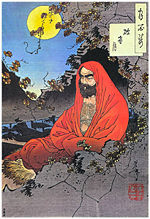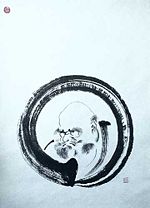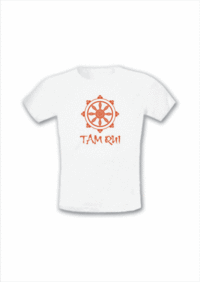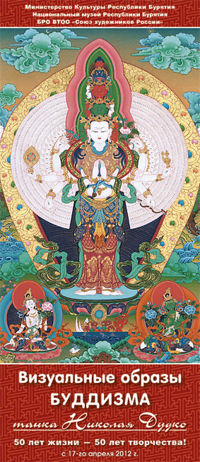Bodhidharma
From Buddha World
Bodhidharma (c. early 5th century CE) was the Buddhist monk traditionally credited as the transmitter of Zen to China. Very little contemporary biographical information on Bodhidharma is extant, and subsequent accounts became layered with legend, but most accounts agree that he was a South Indian Pallava prince-turned-monk who journeyed to Southern China and subsequently relocated northwards. The accounts differ on the date of his arrival, with one early account claiming that he arrived during the Liú Sòng Dynasty (420–479) and later accounts dating his arrival to the Liáng Dynasty (502–557). Bodhidharma was primarily active in the lands of the Northern Wèi Dynasty (386–534). Modern scholarship dates him to about the early 5th century.
Biography
Contemporary accounts
There are two known extant accounts written by contemporaries of Bodhidharma:
Yáng Xuànzhī
A Dehua ware porcelain statuette of Bodhidharma, from the late Ming Dynasty, 17th century
The Record of the Buddhist Monasteries of Luoyang (Luòyáng Qiélánjì), was compiled in 547 by Yáng Xuànzhī, a writer and translator of Mahāyāna Buddhist texts into the Chinese language.
At that time there was a monk of the Western Region named Bodhidharma, a Persian Central Asian. He traveled from the wild borderlands to China. Seeing the golden disks [on the pole on top of Yung-ning's stupa] reflecting in the sun, the rays of light illuminating the surface of the clouds, the jewel-bells on the stupa blowing in the wind, the echoes reverberating beyond the heavens, he sang its praises. He exclaimed: "Truly this is the work of spirits." He said: "I am 150 years old, and I have passed through numerous countries. There is virtually no country I have not visited. But even in India there is nothing comparable to the pure beauty of this monastery. Even the distant Buddha realms lack this." He chanted homage and placed his palms together in salutation for days on end.
Broughton (1999:55) dates Bodhidharma's presence in Luoyang to between 516 and 526, when the temple referred to—Yǒngníngsì — was at the height of its glory. Starting in 526, Yǒngníngsì suffered damage from a series of events, ultimately leading to its destruction in 534.
Tánlín
The second account was written by Tánlín (506–574). Tánlín's brief biography of the "Dharma Master" is found in his preface to the Two Entrances and Four Acts, a text traditionally attributed to Bodhidharma, and the first text to identify Bodhidharma as South Indian:
The Dharma Master was a South Indian of the Western Region. He was the third son of a great Indian king of the Pallava dynasty. His ambition lay in the Mahayana path, and so he put aside his white layman's robe for the black robe of a monk [...] Lamenting the decline of the true teaching in the outlands, he subsequently crossed distant mountains and seas, traveling about propagating the teaching in Han and Wei.
Tánlín's account was the first to mention that Bodhidharma attracted disciples, specifically mentioning Dàoyù and Huìkě, the latter of whom would later figure very prominently in the Bodhidharma literature.
Tánlín has traditionally been considered a disciple of Bodhidharma, but it is more likely that he was a student of Huìkě, who in turn was a student of Bodhidharma.
Later accounts
Dàoxuān
In the 7th-century historical work Further Biographies of Eminent Monks (Xù gāosēng zhuàn), Dàoxuān (596-667) possibly drew on Tanlin's preface as a basic source, but made several significant additions:
This Japanese scroll calligraphy of Bodhidharma reads “Chán points directly to the human heart, see into your nature and become Buddha”. It was created by Hakuin Ekaku (1685 to 1768)
Firstly, Dàoxuān adds more detail concerning Bodhidharma's origins, writing that he was of "South Indian Brahman stock" (nán tiānzhú póluómén zhŏng).
Secondly, more detail is provided concerning Bodhidharma's journeys. Tanlin's original is imprecise about Bodhidharma's travels, saying only that he "crossed distant mountains and seas" before arriving in Wei. Dàoxuān's account, however, implies "a specific itinerary": "He first arrived at Nan-yüeh during the Sung period. From there he turned north and came to the Kingdom of Wei". This implies that Bodhidharma had travelled to China by sea, and that he had crossed over the Yangtze River.
Thirdly, Dàoxuān suggests a date for the Bodhidharma's arrival in China. He writes that Bodhidharma makes landfall in the time of the Song, thus making his arrival no later than the time of the Song's fall to the Southern Qi Dynasty in 479.
Finally, Dàoxuān provides information concerning Bodhidharma's death. Bodhidharma, he writes, died at the banks of the Luo River, where he was interred by his disciple Huike, possibly in a cave. According to Dàoxuān's chronology, Bodhidharma's death must have occurred prior to 534, the date of the Northern Wei Dynasty's fall, because Huike subsequently leaves Luoyang for Ye. Furthermore, citing the shore of the Luo River as the place of death might possibly suggest that Bodhidharma died in the mass executions at Heyin in 528. Supporting this possibility is a report in the Taishō shinshū daizōkyō stating that a Buddhist monk was among the victims at Heyin.
Epitaph for Fărú
The idea of a patriarchal lineage in Chán dates back to the epitaph for Fărú (638–689), a disciple of the 5th patriarch Hóngrĕn (601–674), which gives a line of descent identifying Bodhidharma as the first patriarch.
Yǒngjiā Xuánjué
According to the Song of Enlightenment (Zhèngdào gē) by Yǒngjiā Xuánjué (665-713)— one of the chief disciples of Huìnéng, sixth Patriarch of Chán—Bodhidharma was the 28th Patriarch of Buddhism in a line of descent from Śākyamuni Buddha via his disciple Mahākāśyapa, and the first Patriarch of Chán:
Mahakashyapa was the first, leading the line of transmission; Twenty-eight Fathers followed him in the West; The Lamp was then brought over the sea to this country; And Bodhidharma became the First Father here His mantle, as we all know, passed over six Fathers, And by them many minds came to see the Light.
The idea of a line of descent from Śākyamuni Buddha is the basis for the distinctive lineage tradition of the Chán school.
Anthology of the Patriarchal Hall
In the Anthology of the Patriarchal Hall (Zǔtángjí) of 952, the elements of the traditional Bodhidharma story are in place. Bodhidharma is said to have been a disciple of Prajñātāra, thus establishing the latter as the 27th patriarch in India. After a three-year journey, Bodhidharma reaches China in 527 during the Liang Dynasty (as opposed to the Song period of the 5th century, as in Dàoxuān). The Anthology of the Patriarchal Hall includes Bodhidharma's encounter with Emperor Wu, which was first recorded around 758 in the appendix to a text by Shen-hui, a disciple of Huineng.
Finally, as opposed to Daoxuan's figure of "over 150 years," the Anthology of the Patriarchal Hall states that Bodhidharma died at the age of 150. He was then buried on Mount Xiong'er (Xióng'ĕr Shān) to the west of Luoyang. However, three years after the burial, in the Pamir Mountains, Sòngyún — an official of one of the later Wei kingdoms—encountered Bodhidharma, who claimed to be returning to India and was carrying a single sandal. Bodhidharma predicted the death of Songyun's ruler, a prediction which was borne out upon the latter's return. Bodhidharma's tomb was then opened, and only a single sandal was found inside.
Insofar as, according to the Anthology of the Patriarchal Hall, Bodhidharma left the Liang court in 527 and relocated to Mount Song near Luoyang and the Shaolin Monastery, where he "faced a wall for nine years, not speaking for the entire time", his date of death can have been no earlier than 536. Moreover, his encounter with the Wei official indicates a date of death no later than 554, three years before the fall of the last Wei kingdom.
Dàoyuán
Subsequent to the Anthology of the Patriarchal Hall, the only dated addition to the biography of Bodhidharma is in the 1004 Jingde Records of the Transmission of the Lamp (Jĭngdé chuándēng lù), by Dàoyuán, where it is stated that Bodhidharma's original name had been Bodhitāra but had been changed by his master Prajñātāra.
After Death Soon after his death, someone supposedly witnessed Bodhidharma walking back towards India barefoot and with a single shoe in hand. His grave was later exhumed, and according to legend, the only thing found in it was the shoe he left behind.
- For nine years he had remained and nobody knew him;
- Carrying a shoe in hand he went home quietly, without ceremony.
Modern scholarship
Bodhidharma's origins
Though Dàoxuān wrote that Bodhidharma was "of South Indian Brahman stock," Broughton (1999:2) notes that Bodhidharma's royal pedigree implies that he was of the Kshatriya warrior caste. Mahajan (1972:705–707) argued that the Pallava dynasty was Brahmin by origin but Kshatriya by profession, and Zvelebil (1987) proposed that Bodhidharma was born a prince of the Pallava dynasty in their capital of Kanchipuram.
Yáng Xuànzhī's eyewitness account identifies Bodhidharma as a Persian (bō-sī guó hú rén) from Central Asia (xī yù), and Broughton (1999:54) notes that an Iranian Buddhist monk making his way to North China via the Silk Road is more likely than that of a South Indian master making his way by sea. Broughton (1999:138) also states that the language Yang uses in his description of Bodhidharma is specifically associated with "Central Asia and particularly to peoples of Iranian extraction" and that of "an Iranian speaker who hailed from somewhere in Central Asia". However, Broughton 1999:54 notes that Yáng may have actually been referring to another monk named Boddhidharma, not related to the historical founder of Chan Buddhism.
Bodhidharma known in Chinese as 'Dat-Mo' was the 28th Patriarch in the dhyana (Sanskrit for meditation and hence Ch'an and Zen) Buddhist tradition of India.He had been invited to China by the Emperor Wu, an ardent Buddhist. Bodhidharma later retired to the Shaolin Temple, and according to legend instructed the Monks there in a series of exercises that went on to form the basis of Shaolin Temple 'boxing'. Variously, these exercises are recorded as martial arts techniques and forms from Kerala, or, simply calisthenics, as identified in the 'I Chin Ching' or "Muscle Changing Classic". Extant wall paintings and murals at the Honan Shaolin Temple in North East China show ethnic Indian Monks sparring and training in boxing skills with Chinese Monks, evidence sometimes presented as supporting the view that Bodhidharma's exercises were in fact martial arts - the martial arts of his homeland - Kerala.
Bodhidharma's name
Faure (1986) notes that "Bodhidharma’s name appears sometimes truncated as Bodhi, or more often as Dharma (Ta-mo). In the first case, it may be confused with another of his rivals, Bodhiruci."
Tibetan sources give his name as "Bodhidharmottara" or "Dharmottara", that is, "Highest teaching (dharma) of enlightenment". "Bodhidharma" is presumably a shortened form of this full name.
Practice and teaching
Meditation
Tanlin, in the preface to Two Entrances and Four Acts, and Daoxuan, in the Further Biographies of Eminent Monks, mention a practice of Bodhidharma's termed "wall-gazing" (bìguān). Both Tanlin and Daoxuan associate this "wall-gazing" with "quieting [the] mind" (ān xīn). Elsewhere, Daoxuan also states: "The merits of Mahāyāna wall-gazing are the highest". These are the first mentions in the historical record of what may be a type of meditation being ascribed to Bodhidharma.
In the Two Entrances and Four Acts, traditionally attributed to Bodhidharma, the term "wall-gazing" also appears:
Those who turn from delusion back to reality, who meditate on walls, the absence of self and other, the oneness of mortal and sage, and who remain unmoved even by scriptures are in complete and unspoken agreement with reason.
Exactly what sort of practice Bodhidharma's "wall-gazing" was remains uncertain. Nearly all accounts have treated it either as an undefined variety of meditation, as Daoxuan and Dumoulin, or as a variety of seated meditation akin to the zazen (Chinese: zuòchán) that later became a defining characteristic of Chán; the latter interpretation is particularly common among those working from a Chán standpoint. There have also, however, been interpretations of "wall-gazing" as a non-meditative phenomenon.
The Laṅkāvatāra Sūtra
The Lankavatara Sutra, one of the Mahāyāna Buddhist sūtras, is a highly "difficult and obscure" text whose basic thrust is to emphasize "the inner enlightenment that does away with all duality and is raised above all distinctions". It is among the first and most important texts in the Yogācāra, or "Consciousness-only", school of Mahāyāna Buddhism.
One of the recurrent emphases in the Laṅkāvatāra Sūtra is a lack of reliance on words to effectively express reality:
If, Mahamati, you say that because of the reality of words the objects are, this talk lacks in sense. Words are not known in all the Buddha-lands; words, Mahamati, are an artificial creation. In some Buddha-lands ideas are indicated by looking steadily, in others by gestures, in still others by a frown, by the movement of the eyes, by laughing, by yawning, or by the clearing of the throat, or by recollection, or by trembling.
In contrast to the ineffectiveness of words, the sūtra instead stresses the importance of the "self-realization" that is "attained by noble wisdom" and occurs "when one has an insight into reality as it is": "The truth is the state of self-realisation and is beyond categories of discrimination". The sūtra goes on to outline the ultimate effects of an experience of self-realization:
[The Bodhisattva] will become thoroughly conversant with the noble truth of self-realisation, will become a perfect master of his own mind, will conduct himself without effort, will be like a gem reflecting a variety of colours, will be able to assume the body of transformation, will be able to enter into the subtle minds of all beings, and, because of his firm belief in the truth of Mind-only, will, by gradually ascending the stages, become established in Buddhahood.
One of the fundamental Chán texts attributed to Bodhidharma is a four-line stanza whose first two verses echo the Laṅkāvatāra Sūtra's disdain for words and whose second two verses stress the importance of the insight into reality achieved through "self-realization":
A special transmission outside the scriptures, Not founded upon words and letters; By pointing directly to [one's] mind It lets one see into [one's own true] nature and [thus] attain Buddhahood.
The stanza, in fact, is not Bodhidharma's, but rather dates to the year 1108. Nonetheless, there are earlier texts which explicitly associate Bodhidharma with the Laṅkāvatāra Sūtra. Daoxuan, for example, in a late recension of his biography of Bodhidharma's successor Huike, has the sūtra as a basic and important element of the teachings passed down by Bodhidharma:
In the beginning Dhyana Master Bodhidharma took the four-roll Laṅkā Sūtra, handed it over to Huike, and said: "When I examine the land of China, it is clear that there is only this sutra. If you rely on it to practice, you will be able to cross over the world."
Another early text, the Record of the Masters and Disciples of the Laṅkāvatāra Sūtra (Léngqié shīzī jì) of Jìngjué (683–750), also mentions Bodhidharma in relation to this text. Jingjue's account also makes explicit mention of "sitting meditation", or zazen:
For all those who sat in meditation, Master Bodhi[dharma] also offered expositions of the main portions of the Laṅkāvatāra Sūtra, which are collected in a volume of twelve or thirteen pages, [...] bearing the title of Teaching of [Bodhi-]Dharma.
In other early texts, the school that would later become known as Chán is sometimes referred to as the "Laṅkāvatāra school" (Léngqié zōng).
Portrayals of Bodhidharma
Throughout Buddhist art, Bodhidharma is depicted as a rather ill-tempered, profusely bearded and wide-eyed barbarian. He is described as "The Blue-Eyed Barbarian" (lán yǎnjīngde yěrén) in Chinese texts.
The Anthology of the Patriarchal Hall (952) identifies Bodhidharma as the 28th Patriarch of Buddhism in an uninterrupted line that extends all the way back to the Buddha himself. D.T. Suzuki contends that Chán's growth in popularity during the 7th and 8th centuries attracted criticism that it had "no authorized records of its direct transmission from the founder of Buddhism" and that Chán historians made Bodhidharma the 28th patriarch of Buddhism in response to such attacks.
Legends
Bodhidharma and martial arts
The Yi Jin Jing credits Shaolin Kung Fu to Bodhidharma, which would make him an important influence on Asian martial arts in general. Bodhidharma is remembered in the Kerala Region of Southern India (the Homeland of Kalari) as both a lineage Kalari Master and as the Father of Han-Chinese Shaolin Kung Fu. However, both the attribution of Shaolin Kung Fu to Bodhidharma and the authenticity of the Yi Jin Jing itself have been discredited by historians including Tang Hao, Xu Zhen and Matsuda Ryuchi. This argument is summarized by modern historian Lin Boyuan in his Zhongguo wushu shi as follows:
As for the "Yi Jin Jing" (Muscle Change Classic), a spurious text attributed to Bodhidharma and included in the legend of his transmitting martial arts at the temple, it was written in the Ming dynasty, in 1624, by the Daoist priest Zining of Mt. Tiantai, and falsely attributed to Bodhidharma. Forged prefaces, attributed to the Tang general Li Jing and the Southern Song general Niu Gao were written. They say that, after Bodhidharma faced the wall for nine years at Shaolin temple, he left behind an iron chest; when the monks opened this chest they found the two books "Xi Sui Jing" (Marrow Washing Classic) and "Yi Jin Jing" within. The first book was taken by his disciple Huike, and disappeared; as for the second, "the monks selfishly coveted it, practicing the skills therein, falling into heterodox ways, and losing the correct purpose of cultivating the Real. The Shaolin monks have made some fame for themselves through their fighting skill; this is all due to having obtained this manuscript." Based on this, Bodhidharma was claimed to be the ancestor of Shaolin martial arts. This manuscript is full of errors, absurdities and fantastic claims; it cannot be taken as a legitimate source.
The oldest available copy was published in 1827 and the composition of the text itself has been dated to 1624. Even then, the association of Bodhidharma with martial arts only becomes widespread as a result of the 1904–1907 serialization of the novel The Travels of Lao Ts'an in Illustrated Fiction Magazine.
Huiguang and Sengchou were expert in the martial arts before they became two of the very first Shaolin monks—years before the arrival of Bodhidharma. The Taishō Tripiṭaka documents Sengchou's skill with the tin staff.
Bodhidharma is associated with the idea that spiritual, intellectual and physical excellence are an indivisible whole necessary for enlightenment. Such an approach to enlightenment ultimately proved highly attractive to the Samurai class in Japan, who made Zen their way of life, following their encounter with the martial-arts-oriented Chán Lingji School introduced to Japan by Eisai in the 12th century.
Yet in some versions of his legend, Bodhidharma's focus was so single-minded during his nine years of meditation that his legs atrophied.
In Southeast Asia
In the Malay Peninsula, Bodhidharma was believed to have been a Buddhist monk from South India who came to Palembang by boat. He spent a significant amount of time there before journeying north into Malaysia and Siam. He travelled throughout the Indo-chinese region bringing his knowledge of both Buddhism and martial arts before eventually reaching China.
Encounter with Emperor Liang
According to the Anthology of the Patriarchal Hall, in 527 during the Liang Dynasty, Bodhidharma, the first Patriarch of Chán, visited the Emperor Wu, a fervent patron of Buddhism. The emperor asked Bodhidharma, "What is the highest meaning of noble truth?" Bodhidharma answered, "There is no noble truth." The emperor then asked Bodhidharma, "Who is standing before me?" Bodhidharma answered, "I don't know." The emperor then asked Bodhidharma, "How much karmic merit have I earned by ordaining Buddhist monks, building monasteries, having sutras copied, and commissioning Buddha images?" Bodhidharma answered, "None."
From then on, the emperor refused to listen to whatever Bodhidharma had to say. Although Bodhidharma came from India to China to become the first patriarch of China, the emperor refused to recognize him. Since he refused to believe in what Bodhidharma told him, he practically missed his chance to come face to face with someone who was important to Buddhism. Bodhidharma knew that he would face difficulty in the near future, but had the emperor been able to leave the throne and yield it to someone else, he could have avoided his fate of starving to death.
According to the teaching, Emperor Wu's past life was as a bhikshu. While he cultivated in the mountains, a monkey would always steal and eat the things he planted for food, as well as the fruit in the trees. One day, he was able to trap the monkey in a cave and blocked the entrance of the cave with rocks, hoping to teach the monkey a lesson. However, after two days, the bhikshu found that the monkey had died of starvation.
Supposedly, that monkey was reincarnated into Hou Jing of the Northern Wei Dynasty, who led his soldiers to attack Nanjing. After Nanjing was taken, the emperor was held in captivity in the palace and was not provided with any food, and was left to starve to death. Though Bodhidharma wanted to save him and brought forth a compassionate mind toward him, the emperor failed to recognize him, so there was nothing Bodhidharma could do. Thus, Bodhidharma had no choice but to leave Emperor Wu to die and went into meditation in a cave for nine years.
This encounter would later form the basis of the first kōan of the collection The Blue Cliff Record. However that version of the story is somewhat different. In the Blue Cliff's telling of the story, there is no claim that Emperor Wu did not listen to Bodhidharma after the Emperor was unable to grasp the meaning. Instead, Bodhidharma left the presence of the Emperor once Bodhidharma saw that the Emperor was unable to understand. Then Bodhidharma went across the river to the kingdom of Wei.
After Bodhidharma left, the Emperor asked the official in charge of the Imperial Annals about the encounter. The Official of the Annals then asked the Emperor if he still denied knowing who Bodhidharma was? When the Emperor said he didn't know, the Official said, "This was the Great-being Guanyin (i.e., the Mahasattva Avalokiteśvara) transmitting the imprint of the Buddha's Heart-Mind."
The Emperor regretted his having let Bodhidharma leave and was going to dispatch a messenger to go and beg Bodhidharma to return. The Official then said, "Your Highness, do not say to send out a messenger to go fetch him. The people of the entire nation could go, and he still would not return."
Nine years of gazing at a wall
Failing to make a favorable impression in Southern China, Bodhidharma is said to have retreated to the northern Chinese kingdom of Wei to a cave near the Shaolin Monastery where he "faced a wall for nine years, not speaking for the entire time".
In one version of the story, he is said to have fallen asleep seven years into his nine years of wall-gazing. Becoming angry with himself, he cut off his eyelids to prevent it from happening again. According to the legend, as his eyelids hit the floor the first tea plants sprang up; and thereafter tea would provide a stimulant to help keep students of Chán awake during meditation.
In another version of the story, after the nine years, Bodhidharma "passed away, seated upright".
In another, Bodhidharma disappeared, leaving behind the Yi Jin Jing.
In yet another version of the legend, Bodhidharma's legs atrophied after nine years of sitting, which is why Japanese Bodhidharma dolls have no legs.
Teaching
In one legend, Bodhidharma refused to resume teaching until his would-be student, Hui-k'o, who had kept vigil for weeks in the deep snow outside of the monastery, cut off his own right arm to demonstrate sincerity.
The lineage of Bodhidharma and his disciples
In the Two Entrances and Four Acts and the Continued Biographies of Eminent Monks, Daoyu and Huike are the only explicitly identified disciples of Bodhidharma. The Jingde Records of the Transmission of the Lamp gives Bodhidharma four disciples who, in increasing order of understanding, are Daofu, who attains Bodhidharma's skin; the nun Dharani, who attains Bodhidharma's flesh; Daoyu, who attains Bodhidharma's bone; and Huike, who attains Bodhidharma's marrow.
- Bodhidharma
- Daoyu
- Yuan (Yuan-chi?)
- Tao-chih
- Huike
- Tanlin (506–574)
- Huineng (638-713)
- Hsuan-chueh (665-713)
- Layman Hsiang
- Hua-kung
- Yen-kung
- Dhyana Master Na
- Dhyana Master Ho
- Hsuan-ching
- Ching-ai
- T'an-yen
- Tao-an
- Tao-p'an
- Chih-tsang
- Seng-chao
- P'u-an
- Ching-yuan (1067-1120)
Works attributed to Bodhidharma
- The Outline of Practice or Two Entrances
- The Bloodstream Sutra
- The Breakthrough Sutra
- The Wake-Up Sutra



 По-Русски
По-Русски
